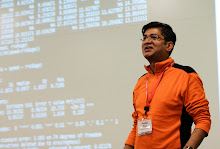Many of the buildings in Mumbai date back to the heyday of the Art Deco (AD) era. Those parts of Mumbai (then known as Bombay) were built and populated in the 1920s and 1930s -- the peak of AD architecture -- so it's natural that the British AD movement would find a home in one of their colonies. Among lovers of AD, Mumbai is well known as "must visit" place to view originally gorgeous but now largely dilapidated or modified (you'll see what I mean by that later in this post) AD architecture. Of course there are some very well preserved AD buildings in the city. And there is a movement among local AD lovers to further preserve whatever they can. Another reason that AD flourished in Mumbai and in some other parts of India was that many of the architectural elements were well suited to the tropical weather. For instance, "eye brows" -- a common feature in AD architecture -- is apt for tropical climates because it provides a shield against the intense rain that this area receives during the monsoon season. Another feature that fits right in is balconies: the warm weather is conducive to people enjoying fresh air by hanging out in their balconies. Additionally, the high population density lends itself well to people-watching from balconies. This may see like a strange thing, but I remember as a child spending a good time hanging out in the balcony just enjoying the tableau below as it unfolded. Large windows that let in fresh air is another feature of AD that found a welcome home in Mumbai buildings.
Now, if you were visiting Mumbai and wanted to visit just one area where you could feast on the AD architecture that the city has to offer, locals would point you to the area just south of Churchgate Station. The area I'm referring to is roughly the red rectangle in this map (click on the map to view a larger version):
From Churchgate Station, if you exit at the southern end you can take the underground walkway to cross the street, skirt Eros Cinema -- itself a superb specimen of AD architecture -- and walk down Maharishi Karve Rd. which borders Azad Maidan. As you walk down that road, on your right you will see some really well-preserved specimens of AD apartment buildings.
About half way down Azad Maidan, if you make a right turn on Dinshaw Vacha Rd. you'll see more of these specimens. I took a slightly different route, but ended up at one lovely specimen: Ram Mahal. Here it is:
Although I'm not an architect, I'm going to take the liberty of "marking up" some interesting AD features of Ram Mahal.
- a. Balconies galore with metallic railings.
- b. "Suntrap" curved corner windows.
- c. Metal framed and glass-windowed stairwell (I'm guessing it's a stairwell).
- d. Tower at the top. This one is quite subdued as far as towers go.
- e. "Eye brows" protecting windows from sun/rain.




No comments:
Post a Comment